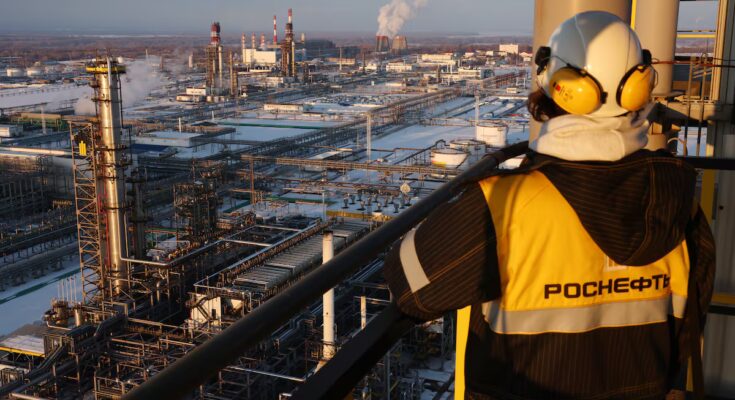Donald Trump’s punishment of Vladimir Putin for his refusal to make concessions in his war against Ukraine has pushed the price of Russian oil to its lowest level since March 2023. The price of a barrel from the Urals last week was between $36.6 and $38.4, according to the Argus agency, implying discounts at its ports of up to $23 compared to the international benchmark Brent. This is not a devastating blow that will end the invasion of Ukraine, but the new US sanctions reduce budgets in which the Kremlin has allocated 38% of spending to strengthen its war machine and grease its repressive forces in the coming years.
The US Treasury Department has set November 21 as the deadline to suspend the purchase of crude oil from Rosneft and Lukoil, two Russian oil giants that sell half of the country’s oil exports abroad.
Lukoil, more exposed to the international market than domestically focused Rosneft, runs the risk of being dismantled. According to Russian media, bidders for his assets include Exxon Mobil, Carlyle and oil states such as the United Arab Emirates.
Although the new sanctions have not yet come into force, the market has started to anticipate their consequences. A report from the Argus, to which Russian media had access, indicates that the discount offered by Russian oil companies to their customers for secretly purchasing from the “shadow fleet” departing from their ports increased from $12 at the end of October to between $17 and $19 a barrel in the first half of November. In the case of direct transport to India, where crude oil is refined and sold to the West, the discount increased from 2.20 to 3.79 dollars, while towards China it was reduced from 1.88 dollars to 0.68 dollars per barrel.
However, large Chinese state-owned companies have blocked virtually all purchases of Russian crude oil due to the threat of Western sanctions, analysts at Rystad Energy revealed to Bloomberg.
Trump’s decision reversed the dissipation of the impact of the $60 ceiling on the price of Russian oil imposed by the West in December 2022. That measure forced Russia to initially apply a discount of up to $30, but the problem of evading sanctions has eroded its effects to less than $5.
“President Trump is the president of peace and prosperity,” the Treasury Department said
According to the International Energy Agency, Russia produces about 9.3 million barrels of oil per day, almost all of its capacity. This institution published a report on November 13 in which it states that “so far Russian exports have continued virtually without interruption, even with the accumulation of large volumes in maritime transit” as its clients analyze the risks of non-compliance with the new sanctions and how to circumvent them.
Crude oil is swirling around the world waiting for Russian customers to clarify whether Trump’s sanctions were a bluff or serious. According to the Bloomberg agency, since August the volume of crude oil loaded by tankers in the middle of the sea has increased by 16%, reaching 175 million tons. Many ships with unknown final destinations head to the Suez Canal from ports in the Baltic, Black Sea and Arctic.
Added to the US sanctions is the Ukrainian punitive campaign against Russian refineries. Rosneft’s largest plant, located in the Ryazan region, about 200 kilometers southeast of Moscow, has suspended its operations for the second time in a month due to drone attacks, sources told the Moscow Times. With this plant, which represents 5% of total Russian refining capacity, five plants were temporarily closed in November.
Although some fuel shortages have occurred in some Russian regions, the impact of Ukrainian bombing has not put Russian production at serious risk. The US agency Reuters estimates that its refineries have reduced their production by just 3% this year due to the attacks. This is explained by the fact that the Russian industry has a total refining capacity of up to 6.6 million barrels per day, a much larger potential than it uses.
Less money for weapons
The Kremlin is trying to clean up accounts that are increasingly constrained by having already spent funds that Russia had accumulated for years, including a cushion of foreign currency resulting from requests by European countries to replenish their gas reserves.
The State Duma, the lower house of the Russian parliament, is about to complete the drafting of next year’s budget. The Russian government plans to increase its revenue to 40,200 billion rubles, around 430 billion euros at current exchange rates, by applying a harsh tax increase with which it hopes to raise another 30 billion euros. For its part, expenses will increase to 44 trillion rubles, or about 468 billion euros, or about 13 billion euros more than in the previous year.
The target is a deficit equal to 1.6% of Gross Domestic Product (GDP) compared to the 2.6% expected this year. A rather high deviation from Russian standards, although lower than Western ones. However, this is one of the Kremlin’s great concerns, especially if the locomotive of the economy is war and not consumption, and revenues from hydrocarbons, 7.5 trillion rubles, have fallen by 21% this year compared to 2024.
The Kremlin will allocate around 30% of its budget, around 137 billion euros, to the armed forces, although its return compared to European military spending is higher because recruiting and producing weapons are “cheaper” for Russia in terms of purchasing power.
Furthermore, this increase in military spending will continue to increase in the coming years. The Russian government plans to allocate around 39.5 trillion rubles, around 420 billion euros, for its armed forces until 2028.
War aside, the Russian government will allocate another 8% of planned spending, around 3.9 trillion rubles, to the security forces with which the Kremlin keeps both its population and its internal factions in line.



